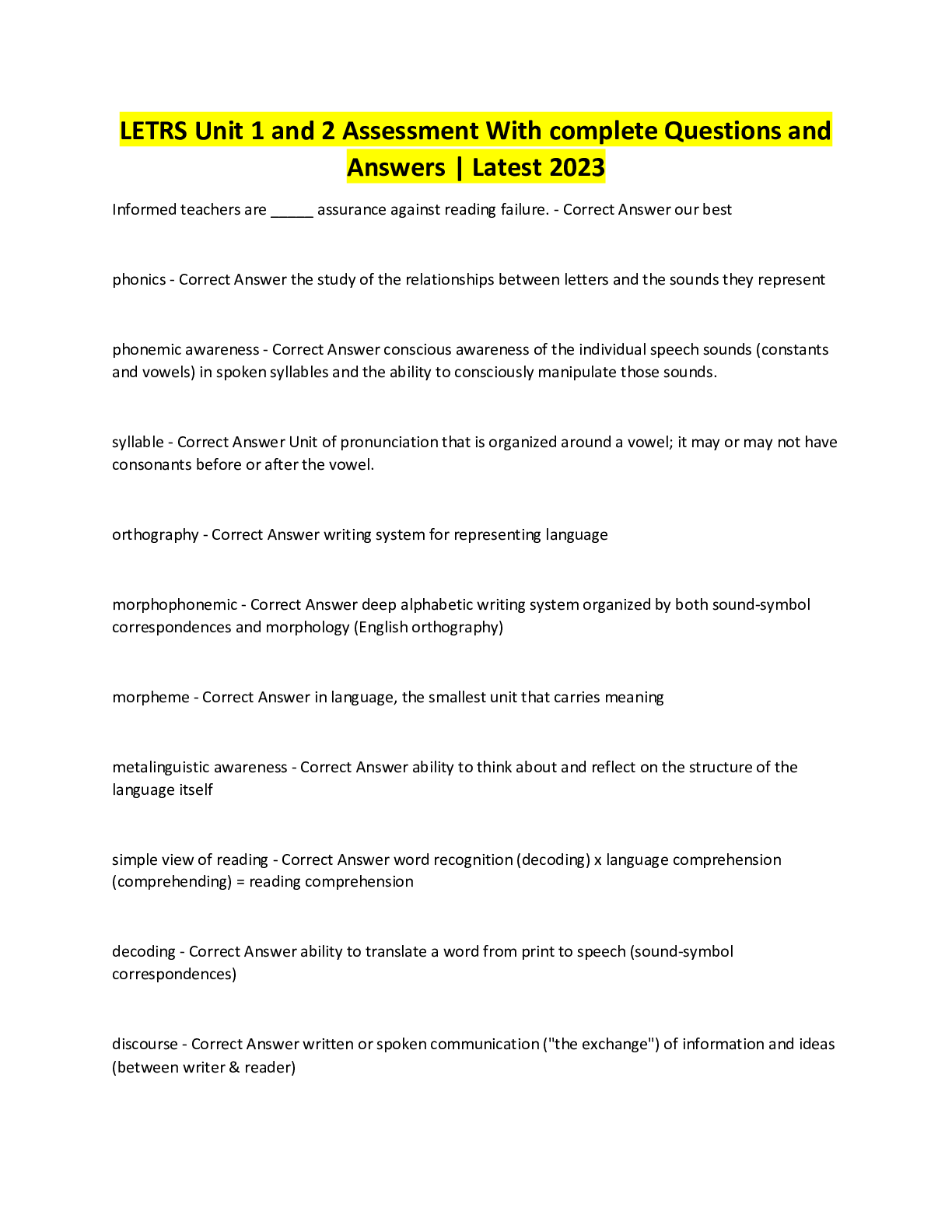Health Care > EXAM > USMLE Step 2 CK High-Yield Complete Test With Questions And Answers 2022 (All)
USMLE Step 2 CK High-Yield Complete Test With Questions And Answers 2022
Document Content and Description Below
USMLE Step 2 CK High-Yield Complete Test With Questions And Answers 2022 Classic EKG finding in atrial flutter Correct Answer: "Sawtooth" p waves Definition of unstable angina Correct Answer: ... Angina that is new, is worsening, or occurs at rest Antihypertensive for a diabetic patient with proteinuria Correct Answer: ACEI Beck's triad for cardiac tamponade Correct Answer: Hypotension, distant heart sounds, and JVD Drugs that slow heart rate Correct Answer: Beta-blockers, CCBs, digoxin, amiodarone Hypercholesterolemia treatment that leads to flushing and pruritus Correct Answer: Niacin Murmur - hypertrophic obstructive cardiomyopathy Correct Answer: A systolic ejection murmur heard along the lateral sternal border that increases with decreased preload (i.e. Valsalva maneuver) Murmur - aortic insufficiency Correct Answer: Austin Flint murmur, a diastolic, decrescendo, low-pitched, blowing murmur that is best heard sitting up; increases with increased afterload (i.e. handgrip) Murmur - aortic stenosis Correct Answer: A systolic crescendo/decrescendo murmur that radiates to the neck; increases with increased preload (i.e. squatting) Murmur - mitral regurgitation Correct Answer: A holosystolic murmur that radiates to the axillar; increases with increased afterload (handgrip) Murmur - mitral stenosis Correct Answer: A diastolic, mid to late, low-pitched murmur preceded by an opening snap Treatment for atrial fibrillation and atrial flutter Correct Answer: If unstable, cardiovert. If stable or chronic, rate control with CCBs or beta-blockers Treatment for ventricular fibrillation Correct Answer: Immediate cardioversion Dressler's syndrome Correct Answer: An autoimmune reaction with fever, pericarditis and increased ESR occurring 2-4 weeks post-MI IV drug use with JVD and holosystolic murmur at left sternal border. Treatment? Correct Answer: Treat existing heart failure and replace tricuspid valve Diagnostic test for hypertrophic cardiomyopathy Correct Answer: Echocardiogram (showing a thickened left ventricular wall and outflow obstruction) Pulsus paradoxus Correct Answer: A decrease in systolic BP of > 10 mmHg with inspiration; seen in cardiac tamponade Classic ECG finding in pericarditis Correct Answer: Low-voltage, diffuse ST-segment elevation Definition of hypertension Correct Answer: BP > 140/90 on 3 separate occasions 2 weeks apart Eight surgically correctable causes of HTN Correct Answer: Renal artery stenosis, coarc of aorta, pheo, Conn's, Cushing's syndrome, unilateral renal parenchymal dz, hyperthyroid, hyperparathyroid Evaluation of pulsatile abdominal mass and bruit Correct Answer: Abdominal U/S and CT Indications for surgical repair of abdominal aortic aneurysm Correct Answer: >5.5cm, rapidly enlarging, symptomatic, ruptured Treatment for acute coronary syndrome Correct Answer: ASA, heparin, clopidogrel, morphine, oxygen, sublingual nitro, IV beta-blockers Metabolic syndrome Correct Answer: Abdominal obesity, high triglycerides, low HDL, hypertension, insulin resistance, prothrombotic or proinflammatory states Appropriate diagnostic test: 50yo male with stable angina can exercise to 85% of maximum predicted heart rate Correct Answer: Exercise stress treadmill with ECG Appropriate diagnostic test: 65yo female with LBBB and severe OA has unstable angina Correct Answer: Pharmacologic stress test (e.g. dobutamine echo) Target LDL in a patient with diabetes Correct Answer: <70mg/dL Signs of active ischemia during stress testing Correct Answer: Angina, ST-segment changes on ECG or decreased BP ECG findings suggestive of MI Correct Answer: ST-segment elevation (depression means ischemia), flattened T waves, Q waves Coronary territories in MI Correct Answer: Anterior wall (LAD/diagonal), inferior (PDA), posterior (left circumflex/oblique, RCA/marginal), septum (LAD/diagonal) A young patient with angina at rest and ST-segment elevation with normal cardiac enzymes Correct Answer: Prinzmetal's angina Common symptoms associated with silent MIs Correct Answer: CHF, shock, AMS Diagnostic test for PE Correct Answer: Spiral CT with contrast Protamine Correct Answer: Reverses effects of heparin Prothrombin time Correct Answer: Coagulation paramter affected by warfarin A young patient with FHx of sudden death collapses and dies while exercising Correct Answer: Hypertrophic cardiomyopathy Endocarditis prophylaxis regimens Correct Answer: Oral surgery - amoxicillin for certain situations; GI or GU procedures - not recommended Virchow's triad Correct Answer: Stasis, hypercoagulability, endothelial damage The most common cause of HTN in young women Correct Answer: OCPs The most common cause of HTN in young men Correct Answer: Excessive EtOH Figure 3 sign Correct Answer: Aortic coarctation Water-bottle shaped heart Correct Answer: Pericardial effusion, look for pulsus paradoxus "Stuck-on" appearance Correct Answer: Seborrheic keratosis Red plaques with silvery-white scales and sharp margins Correct Answer: Psoriasis The most common type of skin cancer; lesion is pearly-colored papule with translucent surface and telangiectasias Correct Answer: Basal cell carcinoma Honey-crusted lesions Correct Answer: Impetigo A febrile patient with h/o diabetes presents with red, swollen, painful lower extremity Correct Answer: Cellulitis Positive Nikolsky's sign Correct Answer: Pemphigus vulgaris Negative Nikolsky's sign Correct Answer: Bullous pemphigoid A 55yo obese patient presents with dirty, velvety patches on the back of the neck Correct Answer: Acanthosis nigricans. Check FBG to r/o diabetes Dermatomal distribution Correct Answer: Varicella zoster Flat-topped papules Correct Answer: Lichen planus Iris-like target lesions Correct Answer: Erythema multiforme A lesion characteristically occurring in a linear pattern in areas where skin comes into contact with clothing or jewelry Correct Answer: Contact dermatitis Presents with a herald patch, Christmas-tree pattern Correct Answer: Pityriasis rosea Pinkish, scaling, flat lesions on the chest and back; KOH prep has a "spaghetti-and-meatballs" appearance Correct Answer: Tinea versicolor Four characteristics of a nevus suggestive of melanoma Correct Answer: Asymmetry, border irregularity, color variation, and large diameter A premalignant lesion from sun exposure that can lead to squamous cell carcinoma Correct Answer: Actinic keratosis "Dewdrops on a rose petal" Correct Answer: Lesions of primary varicella "Cradle cap" Correct Answer: Seborrheic dermatitis. Treat conservatively with bathing and moisturizing agents Associated with Propionibacterium acnes and changes in androgen levels Correct Answer: Acne vulgaris A painful, recurrent vesicular eruption of mucocutaneous surfaces Correct Answer: Herpes simplex Inflammation and epithelial thinning of the anogenital area, predominantly in postmenopausal women Correct Answer: Lichen sclerosus Exophytic nodules on the skin with varying degrees of scaling or ulceration; the second most common type of skin cancer Correct Answer: Squamous cell carcinoma The most common cause of hypothyroidism Correct Answer: Hashimoto's thyroiditis Lab findings in Hashimotos' thyroiditis Correct Answer: High TSH, low T4, anti-TPO antibodies Exophthalmos, pretibial myxedema, and decreased TSH Correct Answer: Graves' disease The most common cause of Cushing's syndrome Correct Answer: Iatrogenic corticosteroid administration. The second most common cause is Cushing's disease A patient presents with signs of hypocalcemia, high phosphorus, and low PTH Correct Answer: Hypoparathyroidism Stones, bones, groans, psychic overtones Correct Answer: Signs and symptoms of hypercalcemia A patient complains of HA, weakness and polyuria; exam reveals HTN and tetany. Labs show hypernatremia, hypokalemia and metabolic alk Correct Answer: Primary hyperaldosteronism (due to Conn's syndrome or bilateral adrenal hyperplasia) A patient p/w tachycardia, wild swings in BP, HA, diaphoresis, AMS and sense of panic Correct Answer: Pheo Which should be used first in treating pheo, alpha or beta-antagonists? Correct Answer: Alpha (phentolamine and phenoxybenzamine) A patient with h/o lithium use p/w copious amounts of dilute urine Correct Answer: Nephrogenic DI Treatment of central DI Correct Answer: Administration of DDAVP and free-water restriction A postop patient with significant pain p/w hyponatremia and normal volume status Correct Answer: SIADH due to stress An antidiabetic agent a/w lactic acidosis Correct Answer: Metformin A patient p/w weakness, n/v, weight loss and new skin pigmentation. Labs show hyponatremia and hyperkalemia. Treatment? Correct Answer: Primary adrenal insufficiency (Addison's). Treat with glucocorticoids, mineralocorticoids and IVF Goal HbA1c for patient with DM Correct Answer: <7.0 Treatment of DKA Correct Answer: Fluids, insulin, and electrolute repletion (eg K+) Why are beta-blockers contraindicated in diabetics? Correct Answer: Can mask symptoms of hypoglycemia Bias introduced into a study when a clinician is aware of the patient's treatment type Correct Answer: Observational bias Bias introduced when screening detects a disease earlier and thus lengthens the time from diagnosis to death Correct Answer: Lead-time bias If you want to know if geographical location affects infant mortality rate but most variation in infant mortality is predicted by socioeconomic status, then socioeconomic status is a ______ Correct Answer: Confounding variable The proportion of people who have the disease and test + is the Correct Answer: Sensitivity Sensitive tests have few false negatives and are used to rule ___ a disease Correct Answer: Out PPD reactivity is used as a screening test because most people with TB (except those who are anergic) will have a positive PPD. Highly sensitivie or specific? Correct Answer: Sensitive. Screening tests with high sensitivity are good for diseases with low prevalence Chronic diseases such as SLE - higher prevalence or incidence? Correct Answer: Higher prevalence Epidemics such as influenza - higher prevalence or incidence? Correct Answer: Higher incidence What is the difference between incidence and prevalence? Correct Answer: Prevalence is the precentage of cases of disease in a population at one snapshot in time. Incidence is the percentage of new cases of disease that develop over a given time period among the total population at risk Cross-sectional survey - incidence or prevalence? Correct Answer: Prevalence Cohort study - incidence or prevalence? Correct Answer: Incidence and prevalence Case-control study - incidence or prevalence? Correct Answer: Neither Describe a test that consistently gives identical results, but the results are wrong Correct Answer: High reliability (precision), low validity (accuracy) Difference between a cohort and a case-control study Correct Answer: Cohort studies can be used to calculate RR< incidence and/or odds ratio. Case-control studies can be used to calculate an OR< which is an estimate of RR when the disease prevalence is low Attributable risk? Correct Answer: The difference in risk in the exposed and unexposed groups (ie, the risk that is attributable to exposure) Relative risk? Correct Answer: Incidence in the exposed group divided by the incidence in the nonexposed group The results of a hypothetical study found an association between ASA intake and risk of heart dz. How do you interpret an RR of 1.5? Correct Answer: In patients who took ASA, the risk of heart dz was 1.5 times that of patients who did not take ASA Odds ratio? Correct Answer: In cohort studies, the odds of developing the disease in the expose group divided by the odds of developing the disease in the nonexposed group. In case-control studies, the odds that the cases were exposed divided by the odds that the controls were exposed. In cross-sectional studies, the odds that the exposed group has the disease divided by the odds that the nonexposed group has the disease The results of a hypothetical study found an association between ASA intake and risk of heart disease. How do you interpret an OR of 1.5? Correct Answer: In patients who took ASA, the odds of acquiring heart disease were 1.5 times those of patients who did not take ASA In which patients do you initiate colorectal cancer screening early? Correct Answer: Patients with IBD, those with familial adenomatous polyposis/hereditary nonpolyposis colorectal cancer, and those who have first-degree relatives with adenomatous polyps (<60 yoa) or colorectal cancer The most common cancer in men and the most common cause of death from cancer in men Correct Answer: Prostate cancer is the most common cancer in men, but lung CA causes more deaths The percentage of cases within 1 SD of the mean? Two SDs? Three SDs? Correct Answer: 68%, 95%, 99.7% Birth rate? Correct Answer: Number of live births per 1000 population in 1 year Mortality rate? Correct Answer: Number of deaths per 1000 population in 1 year Neonatal mortality rate? Correct Answer: Number of deaths frombirth to 28 days per 1000 live births in 1 year Infant mortality rate? Correct Answer: Number of deaths from birth to 1 year of age per 1000 live births (neonatal + postnatal mortality) in 1 year Maternal mortality rate? Correct Answer: Number of deaths during pregnancy to 90 days postpartum per 100,000 live births in 1 year True or false: once patients sign a statement giving consent they must continue treatment Correct Answer: False. Patients may change their minds at any time. Exceptions to the requirement of informed consent include emergency situations and patients without decision-making capacity A 15yo pregnant girl requires hospitalization for preeclampsia. Is parental consent required? Correct Answer: No. Parental consent is not necessary for the medical treatment of pregnant minors A doctor refers a patient for an MRI at a facility he/she owns Correct Answer: Conflict of interest Involuntary psychiatric hospitalization can be undertaken for which 3 reasons? Correct Answer: The patient is a danger to self, a danger to others, or gravely disabled (unable to provide for basic needs) True or false: it is more difficult to justify the withdrawal of futile care than to have withheld the treatment in the first place Correct Answer: False. Withdrawing a nonbeneficial treatment is ethically similar to withholding a nonindicated one A mother refuses to allow her child to be vaccinated Correct Answer: A parent has the right to refuse treatment for his/her child as long as it does not pose a serious threat to the well-being of the child When can a physician refuse to continue treating a patient on the grounds of futility? Correct Answer: When there is no rationale for treatment, maximal intervention is failing, a given intervention has already failed, and treatment will not achieve the goals of care An 8-year-old child is in a serious accident. She requires emergent transfusion, but her parents are not present Correct Answer: Treat immediately. Consent is implied in emergency situations A 15yo girl seeking treatment for an STD asks that her parents not be told about her condition Correct Answer: Minors may consent to care for STDs without parental consent or knowledge Conditions in which confidentiality must be overridden Correct Answer: Real threat of harm to third parties; suicidal intentions; certain contagious diseases, elder and child abuse Involuntary commitment or isolation for medical treatment may be undertaken for what reason? Correct Answer: When treatment noncompliance represents a serious danger to public health (eg TB) A 10yo child presents in status epilepticus, but her parents refuse treatment on religious grounds Correct Answer: Treat because the disease represents an immediate threat to the child's life. Then seek a court order A son asks that his mother not be told about her recently discovered cancer Correct Answer: A physician can withhold information from the patient only in the rare case of therapeutic privilege or if the patient requests not to be told. A patient's family cannot require the physician to withhold information from the patient [Show More]
Last updated: 1 year ago
Preview 1 out of 31 pages
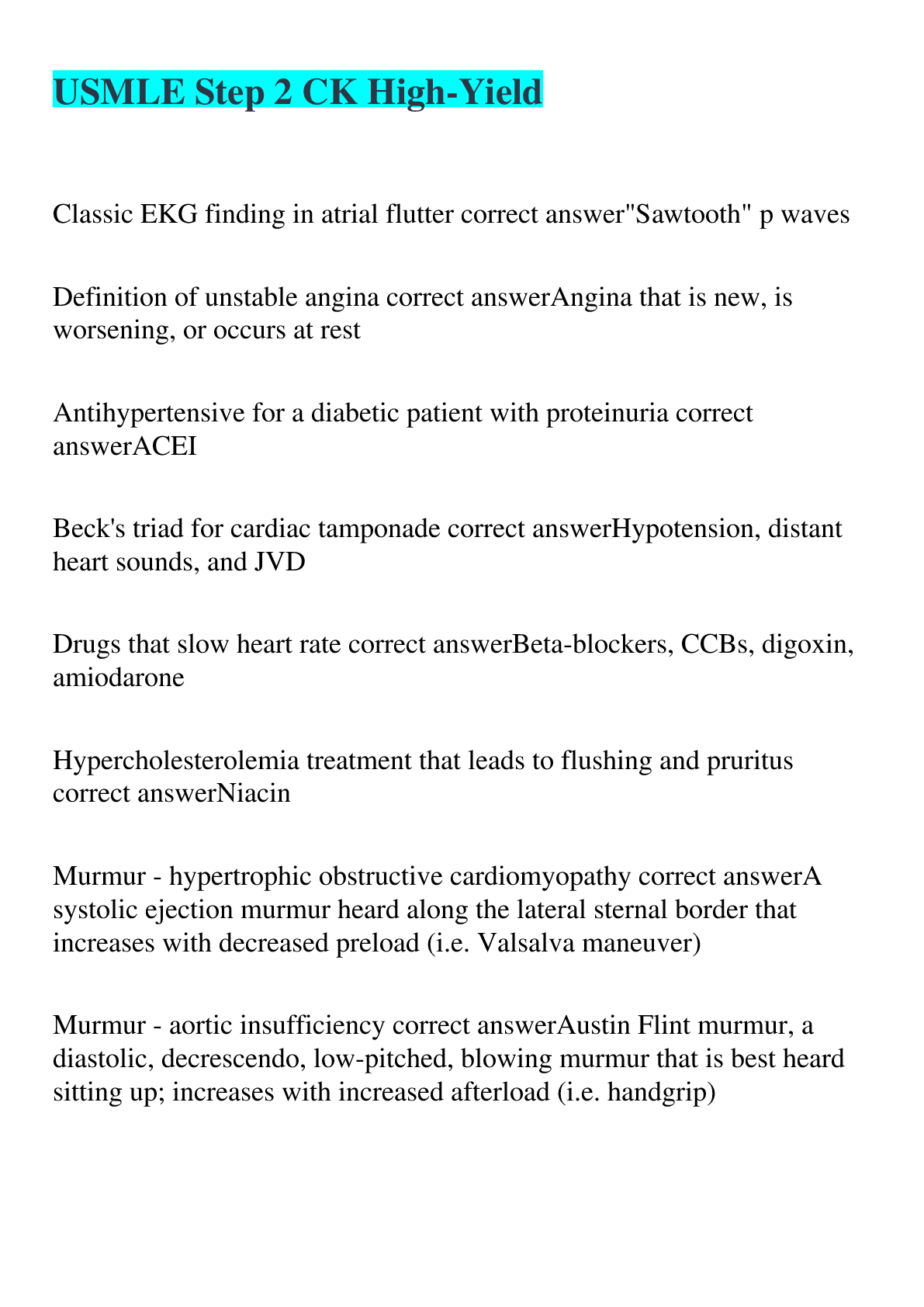
Reviews( 0 )
Document information
Connected school, study & course
About the document
Uploaded On
Aug 06, 2022
Number of pages
31
Written in
Additional information
This document has been written for:
Uploaded
Aug 06, 2022
Downloads
0
Views
88



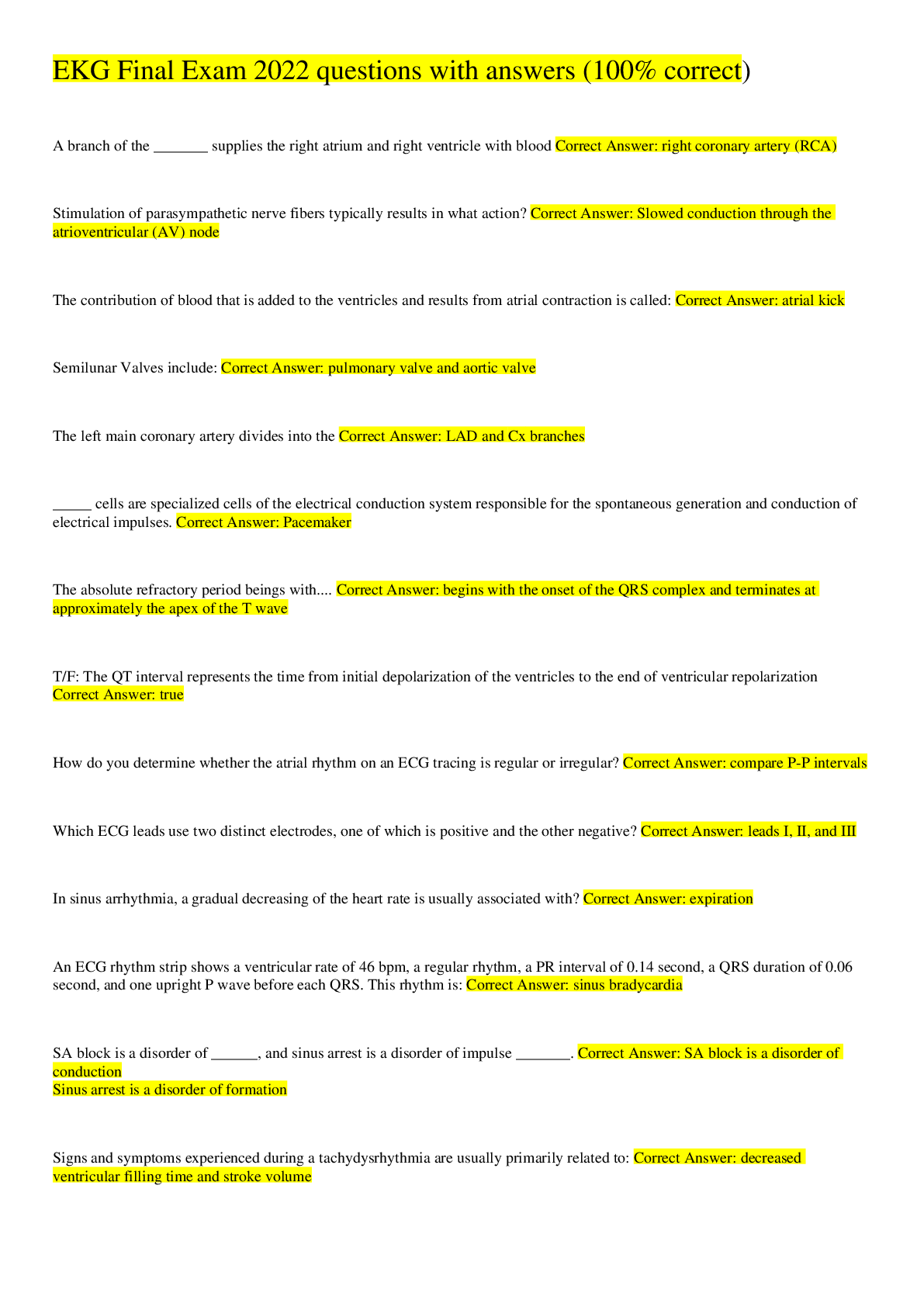
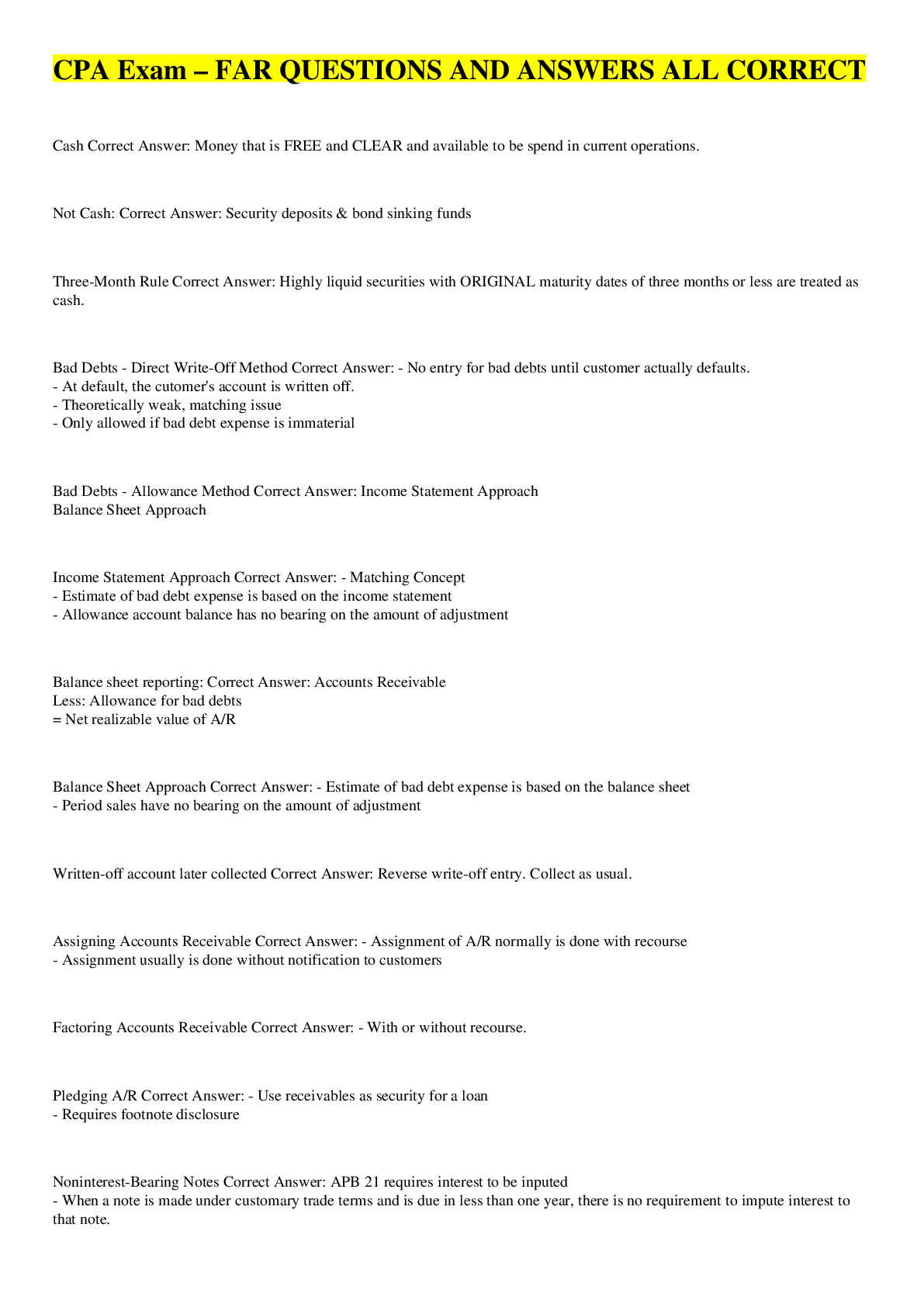
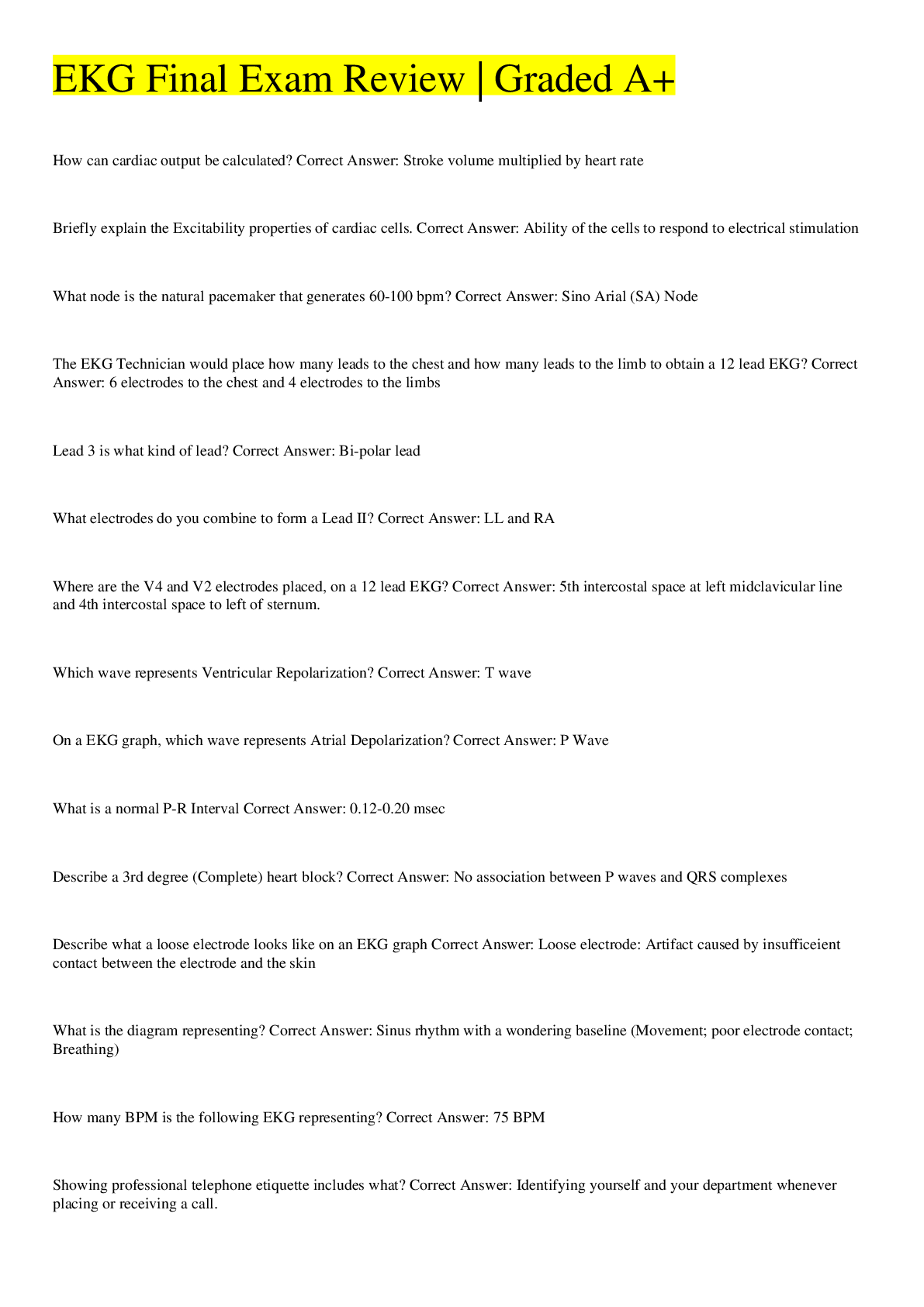
.png)

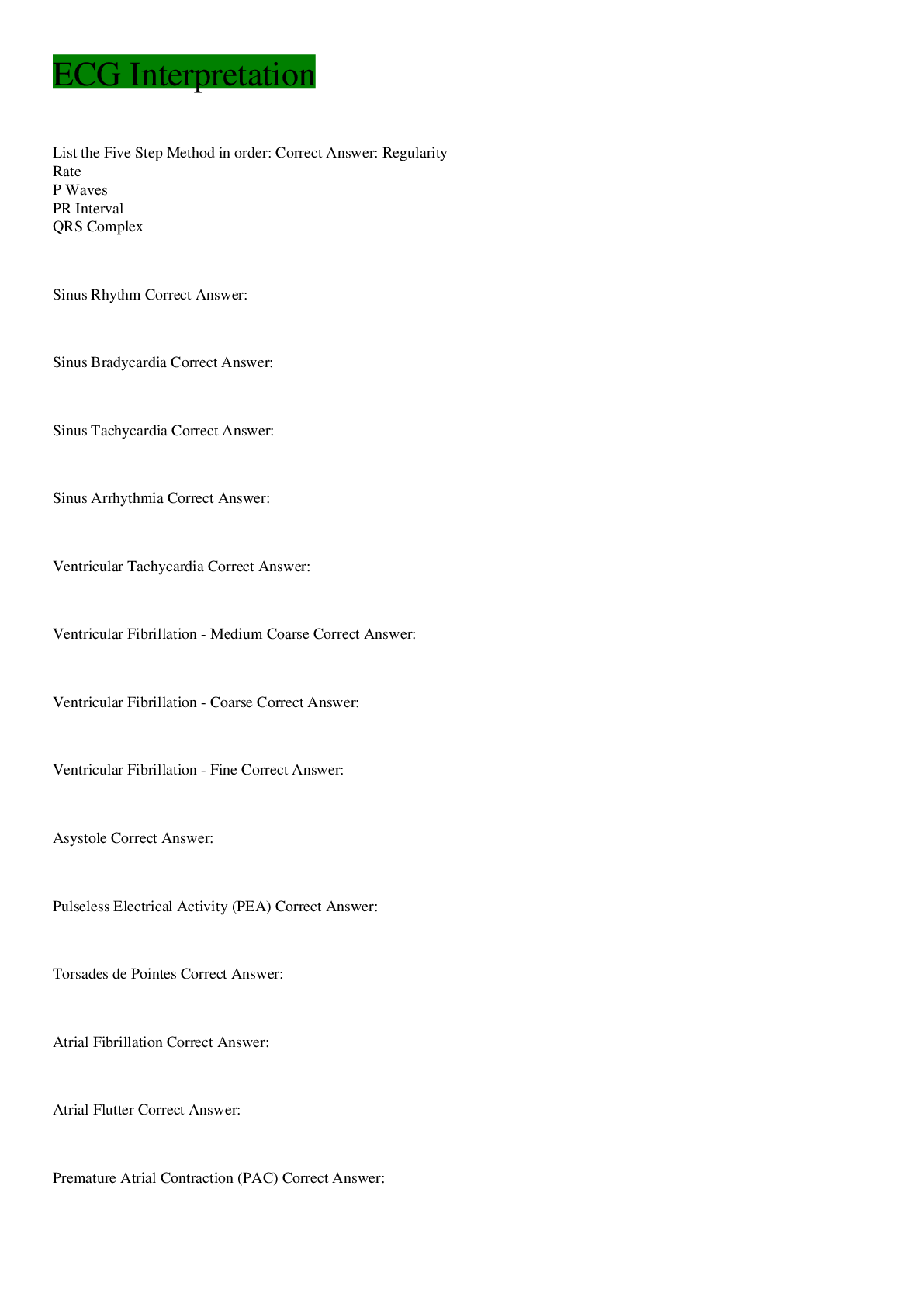


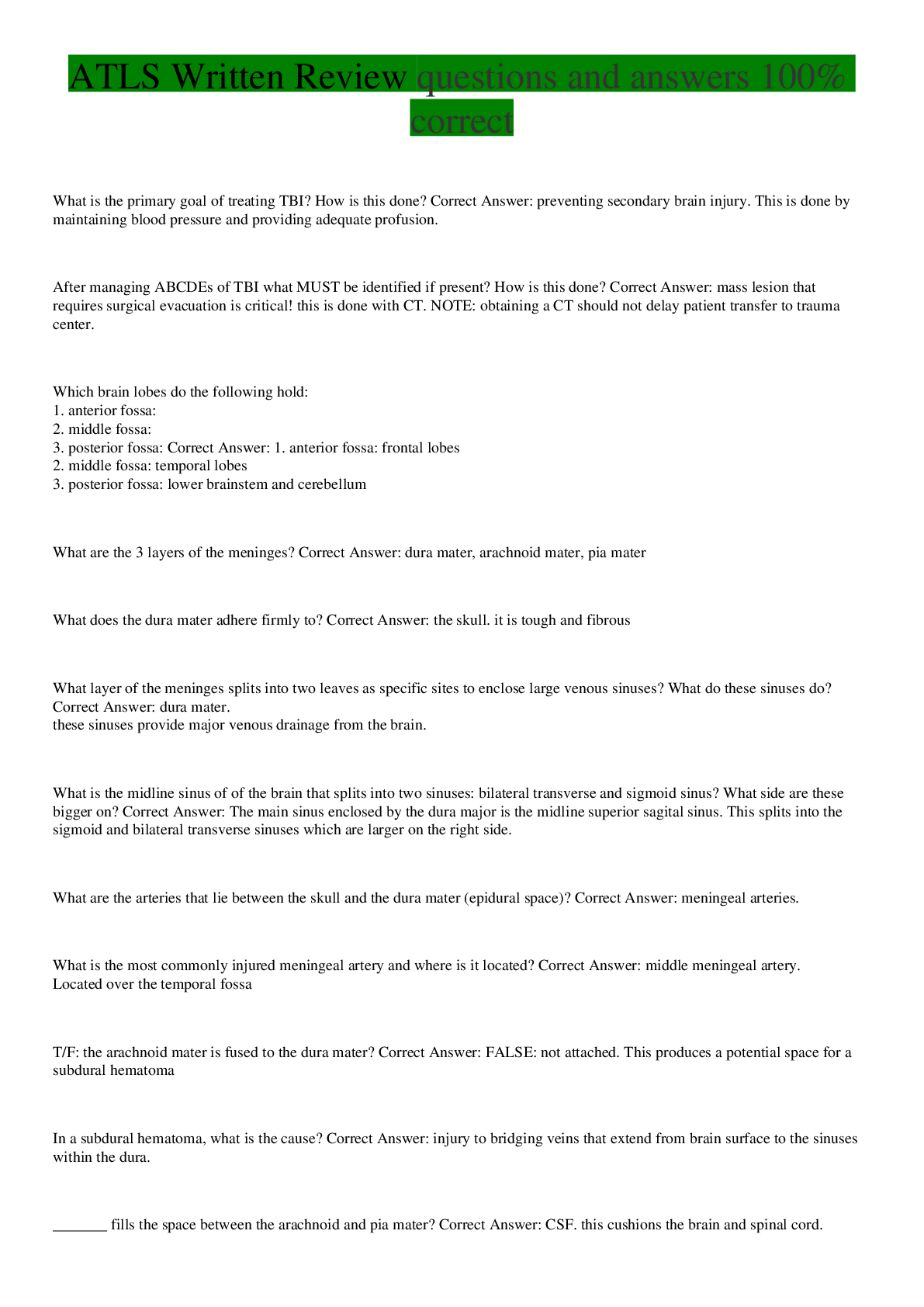
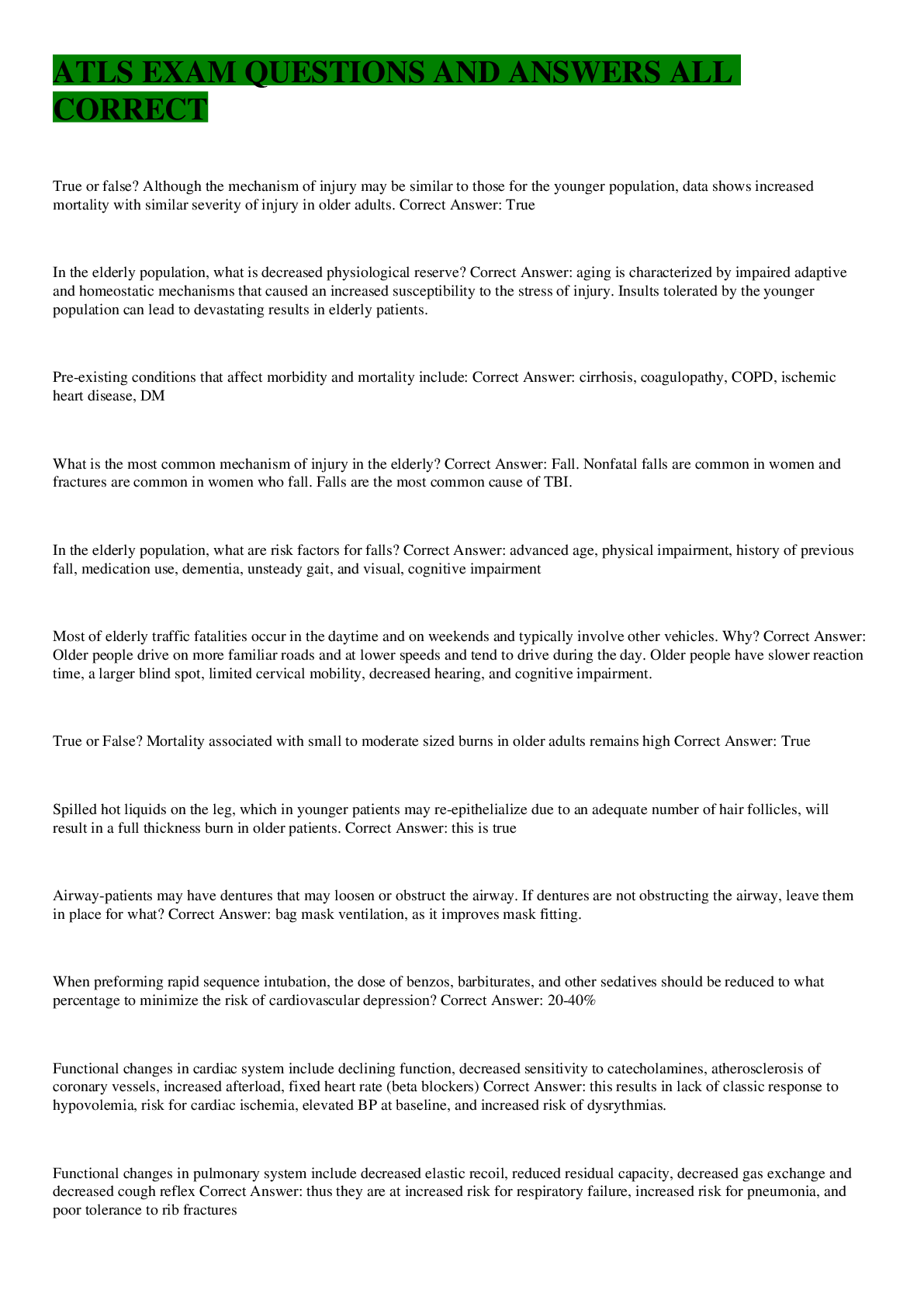


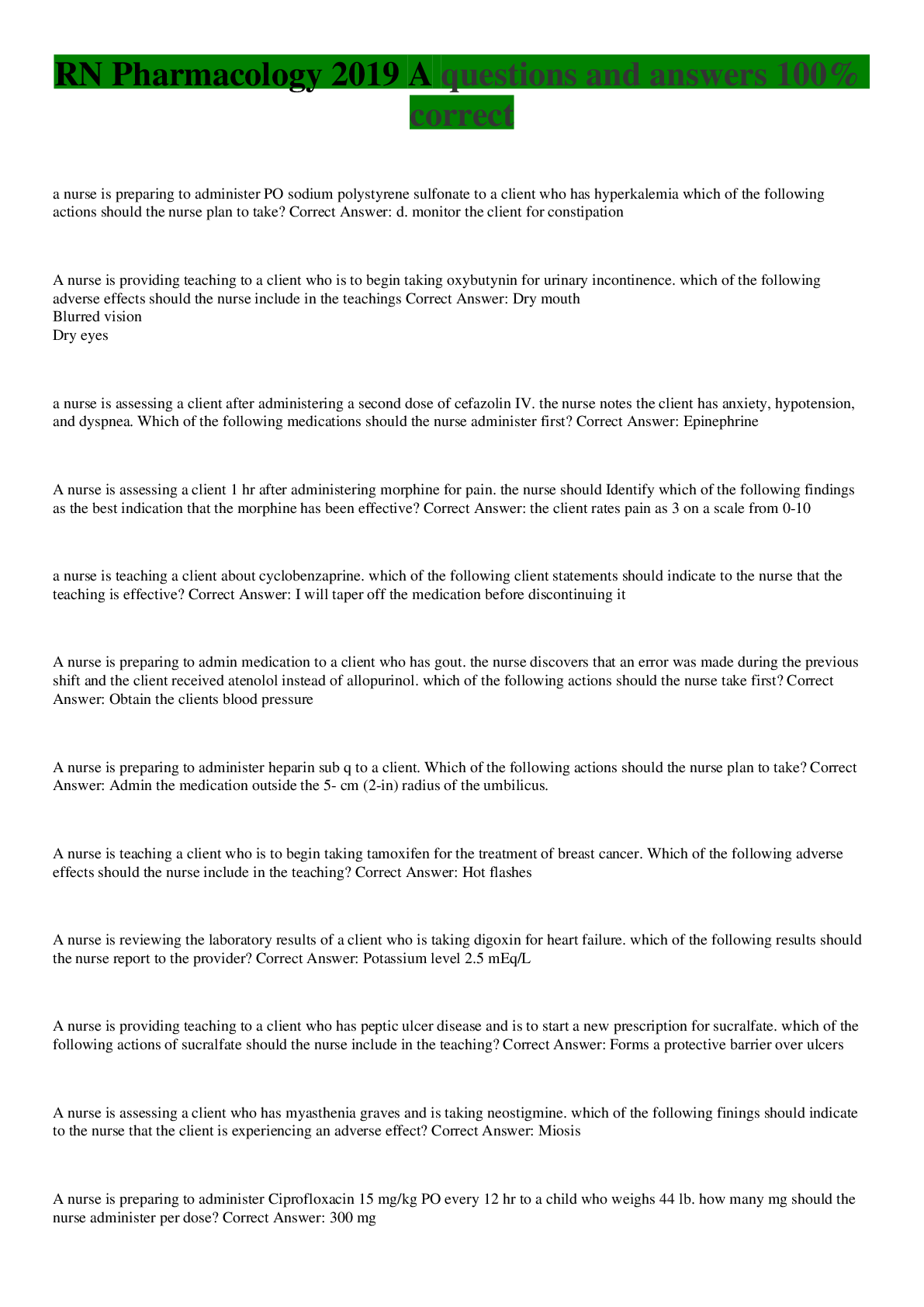
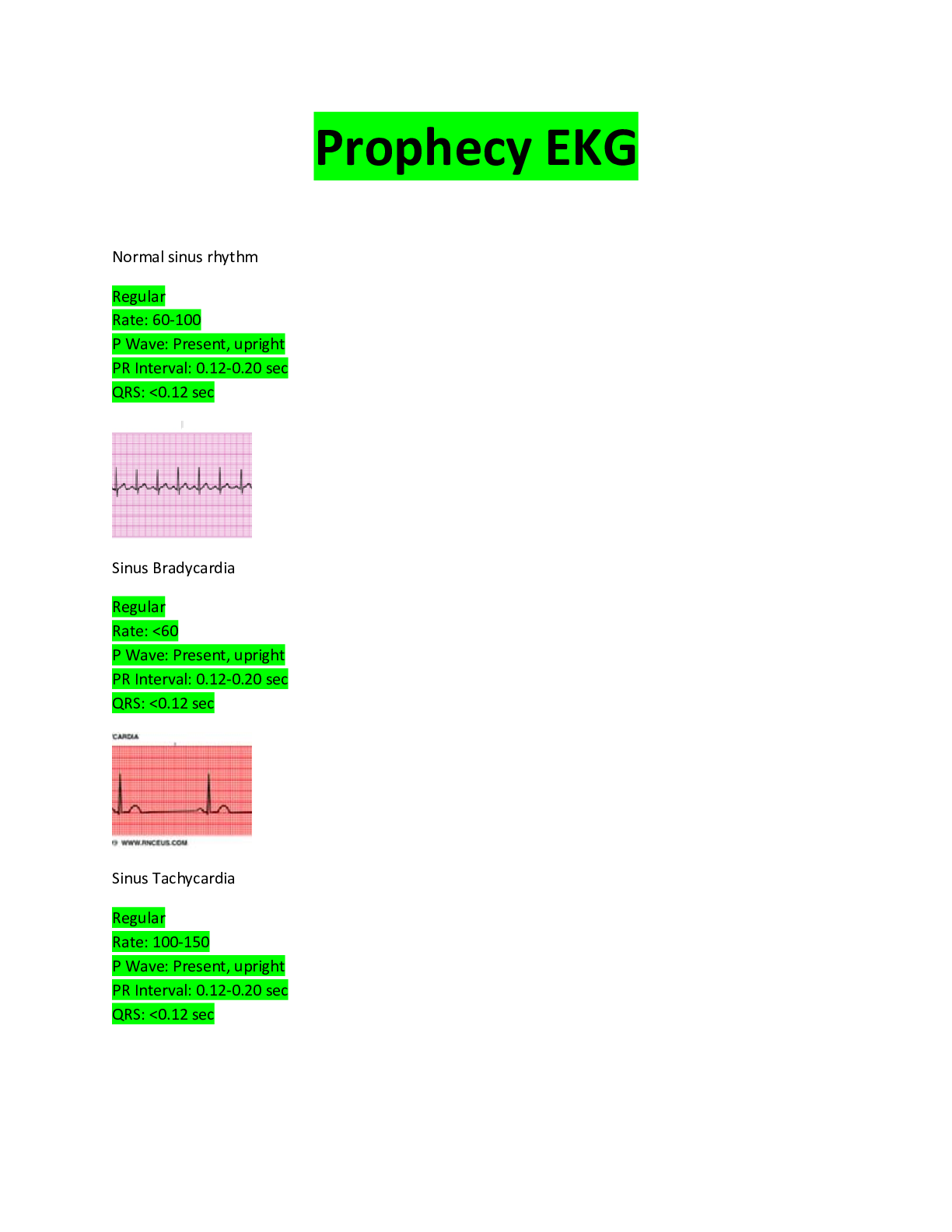



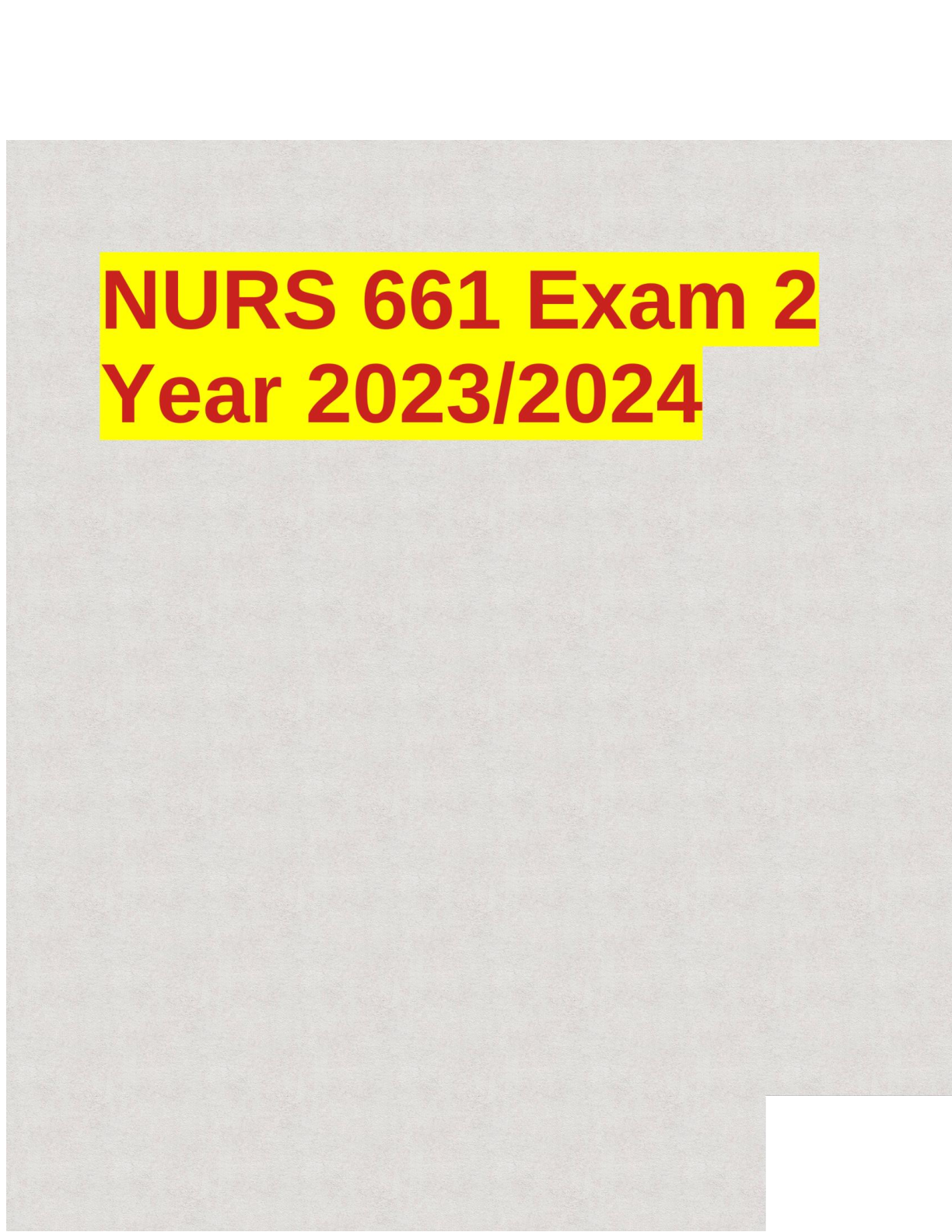



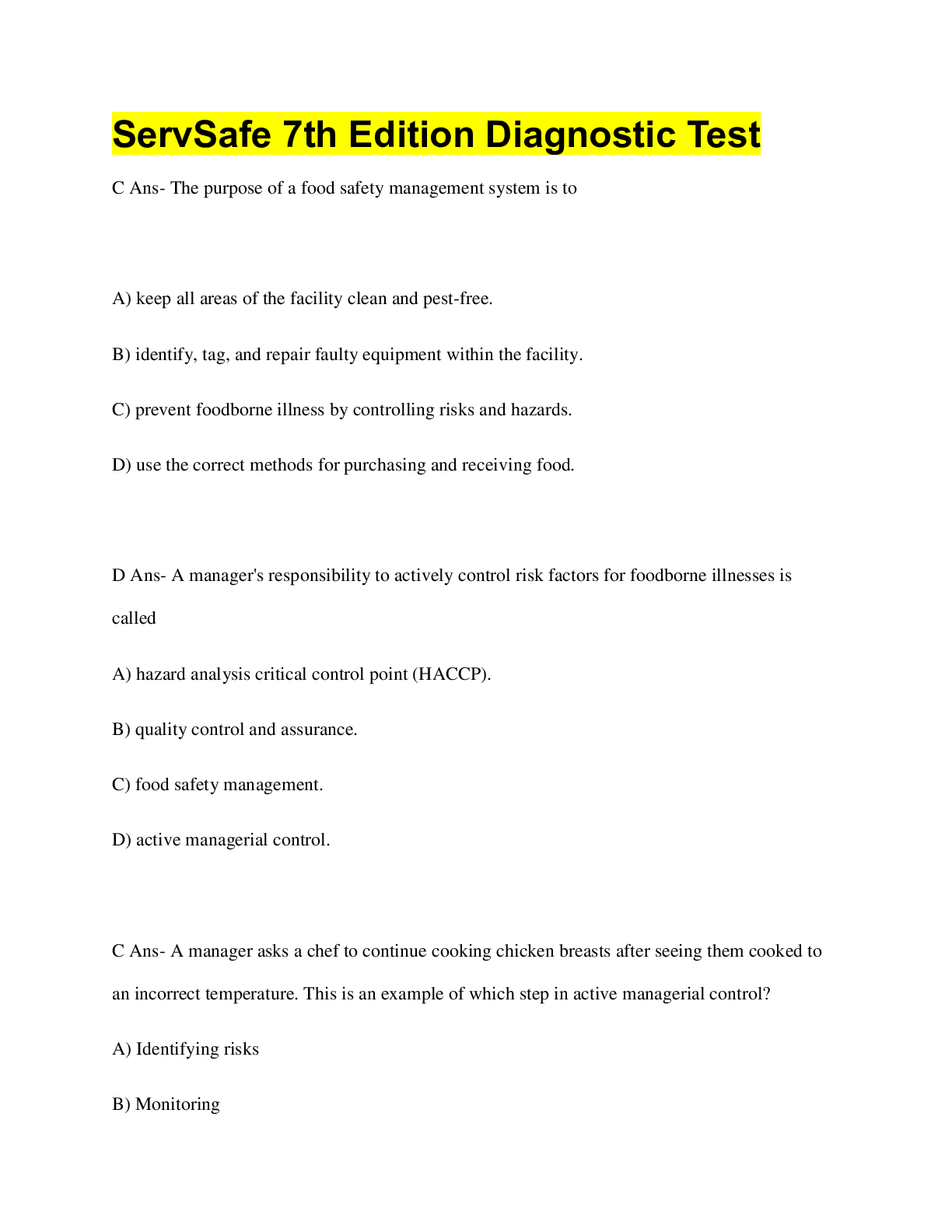
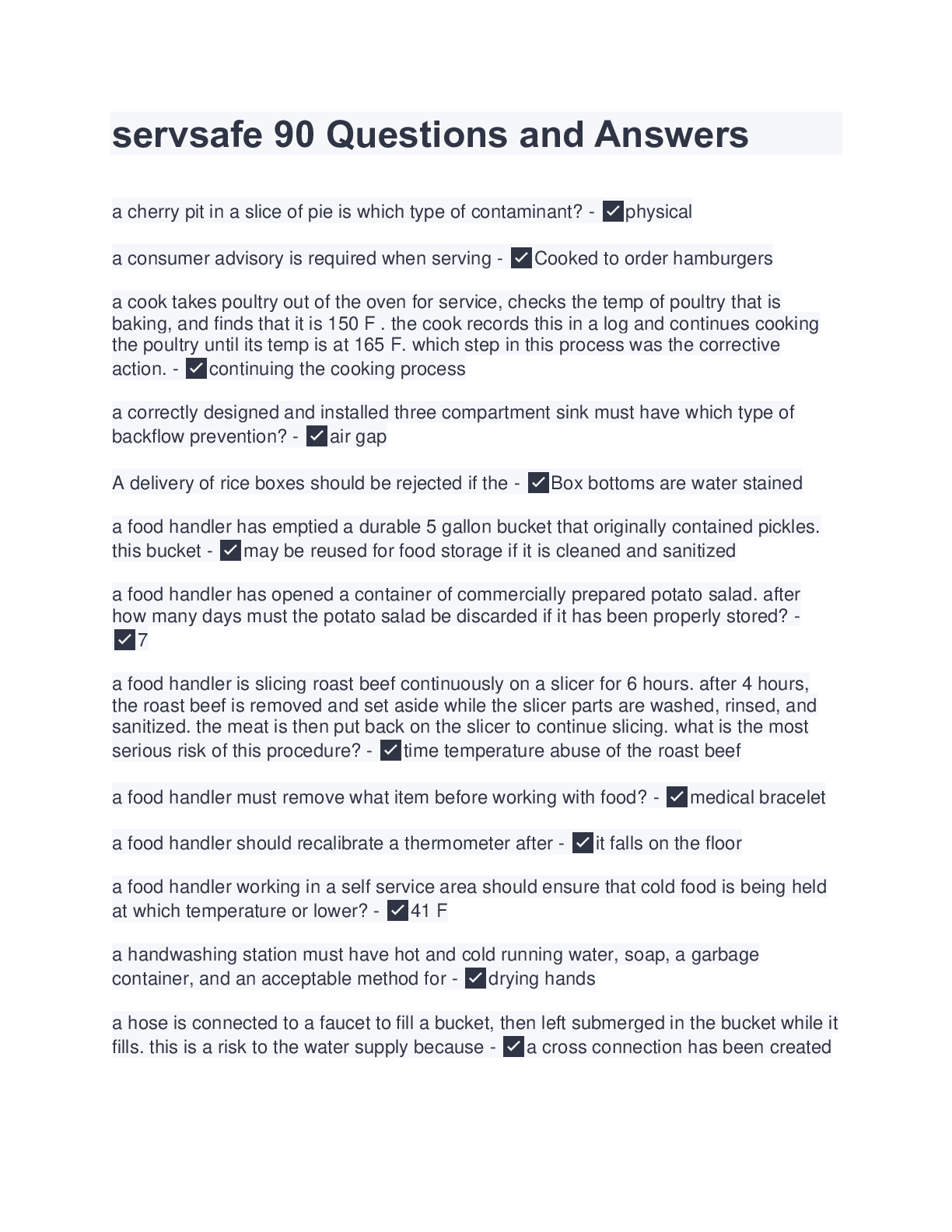
.png)







